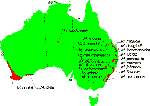Common Names
Burrawangs, Zamia-palms (3).Taxonomic notes
This treatment adopts the species list of Moore (1), who finds 24 described and 3 undescribed (as of 1993) species. See also (4), which I cannot locate and which describes seven species not treated here.Description
"More or less palm-like dioecious plants with a usually unbranched stem forming a rather massive aerial trunk often >50 cm diam., or stem mainly subterranean, covered by the persistent leaf bases; all parts ± pubescent when young, glabrescent with age. Leaves few to numerous, simply pinnate but the pinnae sometimes dichotomously divided, the rachis straight or twisted; base of the petiole swollen, usually silky or tomentose. Pinnae numerous in mature plants, spreading or turned to one side, inserted near the edges of the rachis towards the upper side. Cones axillary, pedunculate; sporophylls terminated by upturned spines; spines usually largest towards apex of cone. Male cones ± cylindrical, often curved when old. Female cones ± ovoid, inner parts often bright pink; sporophylls with 2 ovules; sporophylls fall with attached seeds when ripe; seed with an outer fleshy brightly-coloured layer. "Note: juvenile plants may differ considerably from the adult forms in details of the leaves; in particular the pinnae are usually toothed at the ends and the petioles are long and slender" (3).Range
Australia: Qld, NSW, NT, & WA. Subtropical and warm-temperate areas, usually on poor soils in sclerophyll communities (3).Big Tree
M. dyeri (up to 6.5 m tall and 100 cm diameter) and M. moorei (up to 8 m tall and 80 cm diameter) are the largest species in the genus (1).Oldest
Ethnobotany
Most parts of the plants are toxic. Various species are held responsible for poisoning livestock (3). The seeds are poisonous, but the "Aborigines knew how to treat them to remove the poison, and so take advantage of the large amount of food provided by a single plant. One treatment was to cook the seed, break it up, and then soak it for up to three weeks in running water. In Western Australia, only the outer red part was eaten, after treatment by washing and burying" (2).Observations
Remarks
First known from Oligocene sediments in Tasmania (1).Citations
(1) Jones 1993.(2) Australia National Botanical Garden, Aboriginal Trail page.
(3) Harden 1990.
(4) David L. Jones and Paul I. Forster. 1994. Seven new species of Macrozamia section Parazamia (Miq.) Miq. (Zamiaceae section Parazamia) from Queensland. Austrobaileya 4: 269-288. ABSTRACT: Seven new species of Macrozamia section Parazamia (Miq.) Miq. from south-east Queensland are described and illustrated. They are M. conferta, M. cranei, M. crassifolia, M. machinii, M. occidua, M. parcifolia, and M. viridis. All are restricted endemics allied to either M. plurinervia (L.A.S. Johnson) D.L. Jones or M. pauliguilielmi W. Hill & F. Muell. A key to the species of M. section Parazamia in Queensland is presented.
back | Macrozamia | Zamiaceae | home
This page is from the Gymnosperm Database
URL: http://www.geocities.com/~earlecj/za/ma/index.htm
Edited by Christopher J. Earle
E-mail:earlecj@earthlink.com
Last modified on 31-Oct-1999
